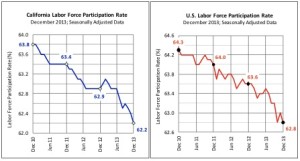Last Friday’s state job numbers showed the California unemployment rate decreasing to 8.3%, from 8.5% in November. This follows a steady drop in unemployment since 2010, when unemployment was at 12.5%.
Job growth explains part of this drop in unemployment—California has gained 922,500 payroll jobs since February 2010. But the drop is also explained by a declining labor force participation rate. The unemployment rate is based on the number of adults classified as looking for jobs. An increasing percentage of California adults no longer say they are actively seeking employment.
This can be seen from the chart below, forwarded by Spencer Wong, chief of EDD’s Labor Market Information Division and one of our foremost labor market researchers in California.
 The labor force participation rate not only declined during the Great Recession in California, but also has fallen since the Great Recession. The current labor force participation rate in California is at its lowest level since 1978. It is below the national rate (also at its lowest level since 1978).
The labor force participation rate not only declined during the Great Recession in California, but also has fallen since the Great Recession. The current labor force participation rate in California is at its lowest level since 1978. It is below the national rate (also at its lowest level since 1978).
Why is this so? A number of dynamics explain the labor force rate decrease: the increased percentage of adults in the 25-54 age range who are staying in school or spending full time on family responsibilities or just not looking for formal employment, the increased number of adults on federal disability rolls (over 900,000 adults in California), and the aging of the labor force in California and retirements.
The most common explanation among California economists for labor market rate participation decrease is the aging of the labor force, the high number of Baby Boomers and their retirements. As the large Baby Boomer cohort ages, it is only natural that labor force participation decreases. The decline in the labor force participation is seen as inevitable, rooted in demographics.
Yet, many of us in California’s workforce community have a different take. What I see, and hear from workforce professionals, is that Californians in their fifties and sixties (and seventies) are leaving the labor force not because they want to do so, but because they are unable to find jobs. At the very time that the health of the more senior workforce in California is better than ever (“60 is the new 40”, as Donna likes to say), so too the difficulty of finding employment for persons over fifty in California is greater than ever.
Actually, employment is not even realistic in many cases of workers over fifty. They’ve entered the gig economy, in which the realistic goal is to cobble together projects, assignments, independent contracts.
Labor force participation rate decline is not undesirable in itself. In the majority of cases, taking care of family members or going to school or engaging in a variety of other “non-work” activities, is of greater social value than the activities constituting paid work in our economy. However, there are more questionable elements of this decline related to the disappearance of employment, that at least should be recognized, and not confused with natural Baby Boomer retirements.

